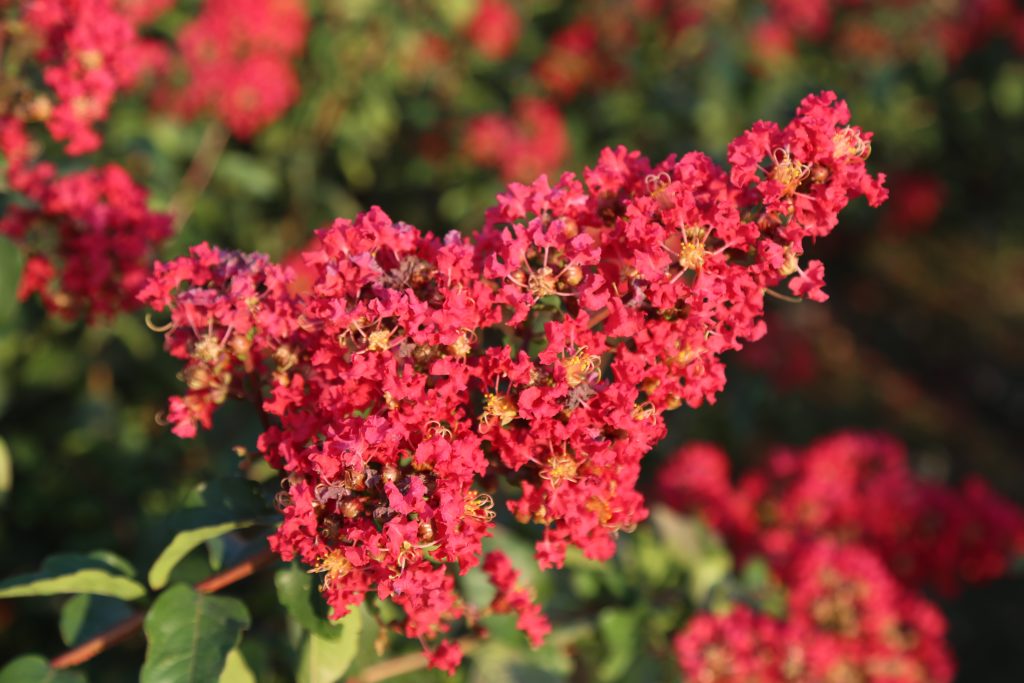Crape myrtle (Lagerstroemia indica) is beloved by gardeners worldwide for its beautiful flowers and rich colors. As a large deciduous shrub or small tree, crape myrtle is highly adaptable, thriving in warm climates and adding year-round color to your garden. This guide will provide detailed information on planting, caring for, and managing crape myrtle, helping you easily grow healthy and beautiful crape myrtle.

Basic Characteristics of Crape Myrtle
Crape myrtle is a uniquely attractive ornamental plant. Its flowers, loosely clustered on inflorescences up to 20 cm long, range in color from white and pink to red and purple. Its leaves turn a vibrant orange or red in autumn, and its bark peels off in winter, adding a touch of vibrant color to the garden.
Once considered delicate, crape myrtle has been cultivated and studied for many years, revealing that many varieties can tolerate temperatures as low as -5°C or -10°C, making them suitable for growing in warm regions. Once established, they are drought-tolerant and easy to manage.
The Best Planting Location for Crape Myrtles
Crape myrtles prefer full sunlight to promote growth and flowering. Therefore, choosing a location with ample sunlight and good drainage is crucial. Ideally, a south- or west-facing border ensures they receive full sun. Avoid shady or north-facing locations, where they may not receive sufficient sunlight, which can affect their flowering and growth.
How to Plant Crape Myrtles
1.Soil Requirements
Crape myrtles prefer fertile, well-drained soil. Before planting, ensure the soil is well-aerated to avoid waterlogging that could damage the roots.
2.Digging a Hole
Dig a planting hole that is twice the width of the crape myrtle’s root ball and deep enough to accommodate the plant’s roots, with the top of the root ball level with the ground. Ensure the soil is loose and supports root growth.
3.Planting Instructions
- Before planting, fill the hole with water.
- Carefully remove the crape myrtle plant and place it in the planting hole.
- Backfill the soil and gently compact it to ensure the plant is firmly established. After completion, water to maintain a moist surface to help the crepe myrtle quickly establish roots.
Crape Myrtle Care and Management
1.Watering
Crape myrtle requires regular watering when newly planted, especially during the hot summer months. Once established, it is quite drought-tolerant, but the soil should still be kept moist during the initial growth phase.
2.Fertilization
Crape myrtle requires adequate fertilizer support during the growing season, especially when grown in pots. Fertilization in spring and autumn helps promote healthy growth and flowering. Use a balanced fertilizer and avoid over-fertilization.
3.Pruning
Crape myrtle generally requires minimal pruning; it is considered a first-line pruning plant. Regularly remove dead branches and intersecting branches to maintain airiness and a beautiful appearance. The best time to prune is in late winter or early spring, when the plant is dormant.
Common Pests and Diseases of Crape Myrtle
Crape myrtle is relatively resistant to pests and diseases, but in high humidity, it may develop powdery mildew. This can affect the bud and bloom period, preventing the flowers from opening properly. If powdery mildew appears, treat with a specialized fungicide to prevent its spread.
Crape Myrtle Purchasing and Selection Tips
Crape myrtles can be grown as shrubs or small trees. When purchasing, ensure the plant is healthy and avoid plants with obvious signs of pests and diseases. Check for a well-developed root system and leaf lesions. A healthy crape myrtle plant should be undamaged and have strong stems and leaves.
Crape Myrtle FAQs
1.What is the maximum height of crape myrtles?
Crape myrtles can grow up to 8 meters tall, but many cultivars are more suitable for home gardens and have a more compact plant height, typically 3-4 meters. Dwarf cultivars,will only reach a maximum of 1.2 meters, making them ideal for potted plants.
2.Can crape myrtles adapt to cold climates?
Crape myrtles are suitable for warm climates, but in colder regions, they can be planted against a south-facing wall for more sunlight and, if necessary, moved to a greenhouse or conservatory to survive the cold winter.
Crape myrtle is a beautiful and enduring plant that can add vitality and color to your garden. Whether in a large garden or a small balcony, its vibrant blooms and ever-changing beauty create a stunning landscape. By studying this guide, you will master crape myrtle cultivation techniques and easily create a beautiful sea of flowers. If you have further questions, please feel free to contact us. Jinfeng are here to provide you with professional advice and assistance.

